Yellowstone National Park - North
Mammoth Hot Springs, Tower-Roosevelt, Lamar Valley
northwest corner of Wyoming
Visited: August 22, 2004
NPS Site Visited: 84 of 353
NPS Website; USGS Website
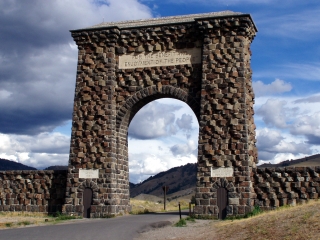 Yellowstone National Park is a diverse natural wonderland roughly twice the size of the state of Delaware. Yellowstone National Park is a diverse natural wonderland roughly twice the size of the state of Delaware.
Because of the Park’s immense size and staggering variety of experiences, we have broken our Yellowstone reviews into three separate entries: the North, Central and South.
WHAT IS IT?
Yellowstone’s northern tier exists outside of the Yellowstone caldera and, as a result, enjoys a much greater variety of plant and animal life. Herds of bison roam the expanses of the Lamar Valley, joined by wolf packs, pronghorns and elk.
Most of Yellowstone’s easily accessible mountain peaks are here in the North. Nearly all of the Park’s bighorn sheep live in the alpine terrain just south of Tower Fall around Mount Washburn.
The North's most famous attraction is Mammoth Hot Springs. This extensive system of multihued cascading hot springs is very similar in geological development and appearance to the interior of spectacular caverns like Carlsbad and Mammoth. At Yellowstone, nature has been turned inside out.
The Mammoth Hot Springs exist outside the caldera and bubble and flow from the heat generated by the slow northeastward movement of the Jackson Hot Spot; the same Hot Spot that ten of thousands of years ago created the lava fields at Craters of the Moon NM and the rich potato-growing soils of southern Idaho.
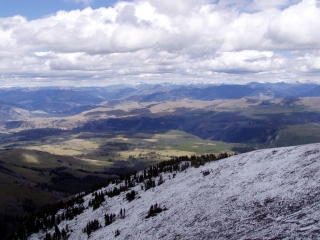 BEAUTY (10/10) BEAUTY (10/10)
The North was the most beautiful part of the Park, especially the Lamar Valley. More wildlife, more diversity, higher mountains and supernatural hot springs.
HISTORIC SIGNIFICANCE (10/10)
In 1872, Yellowstone became the world’s first National Park, the first time land had ever been set aside for public use. Yellowstone NP served as the initial model for the conservation of our precious landscape.
The area also boasts of a long and important Native American history. The obsidian found throughout the Park was the most widely traded good in North American for thousands of years. Indians ranging throughout the continent fashioned arrowheads almost exclusively from materials mined here.
CROWDS (9/10)
Everybody in the North was so happy. We encountered so many different and excited people many of whom gave us indelible memories. There is much space and a wide array of activities nearby: fly fishing, auto touring, wildlife watching, hikes along paved walkways and boardwalks, moderate hikes through valleys, strenuous hikes up mountains and little used backcountry trails.
As soon as you venture away from the road, you see few people. The Beaver Ponds Loop Trail begins and ends in the heavily trafficked Mammoth Hot Springs area. Once we started hiking, we saw more elk than humans. Solitude is possible but hardly necessary given the giddy joy on all faces.
EASE OF USE/ACCESS (3/5)
North Yellowstone can be accessed from Interstate 90 in Montana via U.S. Route 89 and U.S. Route 212.
Route 89 travels 58 miles south from Livingston, Mont. to Mammoth Hot Springs. This scenic route follows the Yellowstone River the whole way and enters the Park underneath the imposing stone Roosevelt arch at the Park’s North Entrance.
Route 212, the Beartooth Highway, is a 124 mile drive from Billings, Mont. It is one of America’s most scenic drives. Starting in Red Lodge, Mont., it climbs tremendous heights, eventually crossing the Wyoming border at the 10,947 Beartooth Pass. The road passes through the Custer and Shoshone National Forests and is every bit as stunning as the Going-to-the-Sun Road at Glacier NP. Understandably, it weather often makes it impassable.
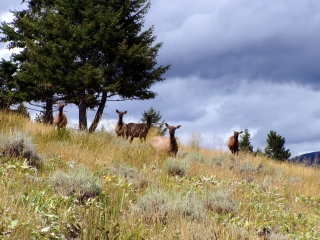 Route 212 enters the Park at Silver Gate, Mont., the Northeast Entrance, and travels 29 miles through the Lamar Valley before reaching the Yellowstone Figure Eight Driving Loop at Tower-Roosevelt. The Lamar Valley is home to much of the Park’s wildlife and is seldom traveled because it is outside the standard auto tour loop. Route 212 enters the Park at Silver Gate, Mont., the Northeast Entrance, and travels 29 miles through the Lamar Valley before reaching the Yellowstone Figure Eight Driving Loop at Tower-Roosevelt. The Lamar Valley is home to much of the Park’s wildlife and is seldom traveled because it is outside the standard auto tour loop.
The North section of Yellowstone NP forms the ? portion of the Figure Eight Driving Loop.
Once you get to Yellowstone, the Park is very accessible. Numerous pull offs and picnic areas allow the motorist to see oodles of wildlife. Mammoth Hot Springs can be closely viewed due to an extensive boardwalk system that is constantly being rebuilt. Yellowstone NP makes incredible efforts to ensure the visitor an optimum experience.
CONCESSIONS/BOOKSTORE (5/5)
The Yellowstone Association runs eight different (and all outstanding) online bookstores in the Park. The Mammoth Hot Springs Visitor Center hosts their only store in the North.
Two full-service dining rooms, one at the Roosevelt Lodge and one at the Mammoth Hot Springs Lodge offers meals and full Verizon cellular service.
COSTS (3/5)
A $20 vehicle entrance fee is good for a week’s stay at both Yellowstone NP and Grand Teton NP, an incredible bargain given the sheer amount of things to see in the Parks’ combined 2.5 million acres. And it's all free with the National Parks Pass!
The North has five campgrounds and 237 campsites; all NPS-run and first-come, first-serve. Mammoth campground is Yellowstone’s only year-round campsite. These are some of the Park’s most popular car camping sites and often fill up early.
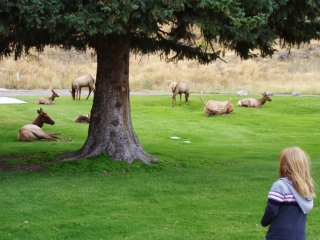 There are Xanterra-run lodges, cabins and hotel rooms at both Roosevelt and Mammoth. There are Xanterra-run lodges, cabins and hotel rooms at both Roosevelt and Mammoth.
Backcountry camping is free. If you're the worrisome type you can make ahead of time reservations for $20 per trip.
RANGER/GUIDE TO TOURIST RATIO (5/5)
Rangers are everywhere and they do a terrific job. Amidst the madness of the heavily touristed Mammoth Hot Springs Visitor Center, Gab received day hike brochures covering six of the Park’s major areas. The Ranger took the time to pick out her favorite hikes on all six and explain that she has made a concerted effort to try them all. Her picks were all stellar.
A zoologist Ranger spots wolves along the Lamar Valley road nearly every day. Her stories of the wolf pack soap opera-esque saga are legendary.
TOURS/CLASSES (9/10)
Yellowstone NP offers so many Ranger Programs that it distributes an 8-page newspaper handout to everyone entering the park regarding these tours. The number of programs tapers severely as the seasons change and the weather turns nasty. Take a tour here. The Rangers are great.
We took the Mammoth Hot Spring Terrace Walk during what was technically summer. The cold rains came and our delightful Ranger immediately made sure to put the plastic weather guard on her signature straw hat. The weather did not deter our tour, but it was nice to linger in the warm steam of the Hot Springs.
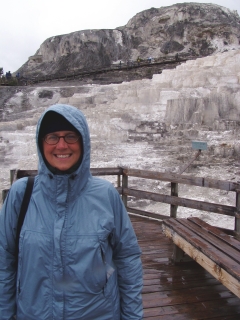 We gained a good understanding of the tricky geological notions of calderas, supervolcanoes, hot spots and travertine formations. Her talk was a remarkable introduction to the mystical steaming world of Yellowstone. We gained a good understanding of the tricky geological notions of calderas, supervolcanoes, hot spots and travertine formations. Her talk was a remarkable introduction to the mystical steaming world of Yellowstone.
For $0.50 a pop, the Yellowstone Association provides helpful glossy, color self-guided trail booklets for nearly every sub-section of the Park.
FUN (10/10)
The Mammoth campground hosts were greeted by us every morning as we extended our stay “just one more day”. This happened three times. Rangers told us that the best hikes in the Park are in the North. We have no reason to argue.
The North also felt less crowded and more off the beaten path. The outsourced lodges, campsites and gift stores have less of a presence. If it hadn’t been for the crazy weather we don’t know if we ever would have left.
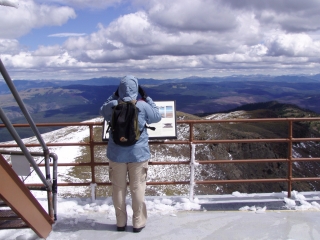 WOULD WE RECOMMEND? (10/10) WOULD WE RECOMMEND? (10/10)
Oh my heavens yes. Yellowstone NP is the classic National Parks destination. Much to our delight the Museums, tours, staffing and bookstores are all equal to the stunning natural surroundings.
Everything here is done right.
We loved the North and would love to spend days, if not weeks, in the backcountry here sometime soon.
TOTAL 74/80
|